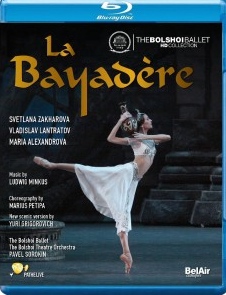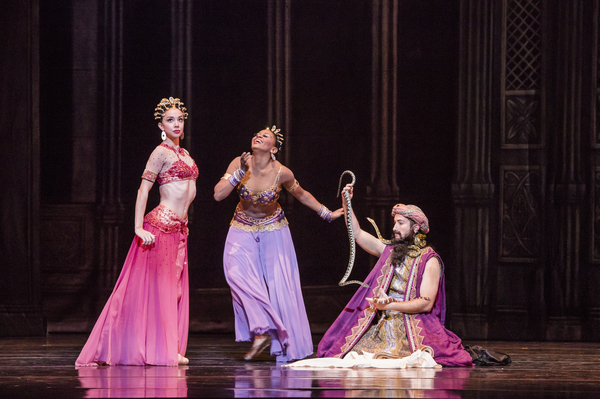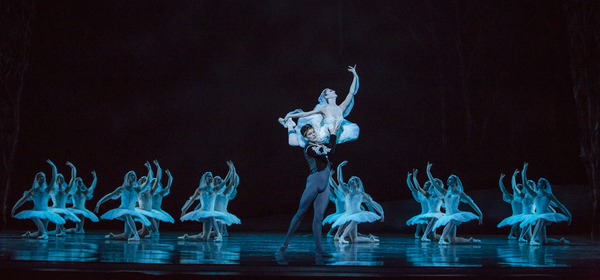The impressive sets and exquisite costumes for Yuri Grigorovich’s staging of La Bayadere primed me to be blown away by the whole production. It’s superbly danced, but some just-missed dramatic moments left me wanting more at the final curtain.
In scale and technical execution, the ballet is outstanding, as should be expected from one of the world’s top companies. Parades of dancers with scarves, fans, drums, birds, and water jugs fill the first two acts in strings of divertissements celebrating the engagement of Gamzatti (Maria Alexandrova) and Solor (Vladislav Lantratov). When the High Brahmin reveals Solor’s involvement with Nikiya, a temple dancer (Svetlana Zakharova), Gamzatti vows to seek revenge. After Nikiya’s death by snakebite, Solor falls into an opium dream in which Nikiya is multiplied by thirty-five shadows. His guilt and despair remain unresolved as the curtain closes on the third act.
Few companies display character dances as energetic as the Bolshoi, and those in Bayadere are no exception. The drum dance is a highlight of the Act 2 variations. The dances for the bridal attendants look crisp and fresh. Soloists in all three acts excel dancing to tempi that bit excitingly at their heels.
As Gamzatti, Alexandrova commands the palace scenes. She’s a haughty woman, fully in control of her body, her kingdom, and her future. Her rage toward Nikiya is unsettling, lending suspense to her forced composure as the Bayadere dances. Lantratov’s Solor seems youthful in comparison to her power.
Zakharova’s extreme flexibility is hypnotizing, but her Nikiya is frequently unreadable. She really opens up in a solo in Act 2, dancing a plea to the gods accompanied by a lone cello. Her prayer is in vain; after an inconvenient dance with a basket of flowers, a snake hidden inside the basket bites her fatally. In this version, Gamzatti is never implicated. Who would dare accuse Alexandrova?
After the extravagance of the first two acts, I looked forward to the simplicity of the Kingdom of the Shades. The Shades’ entrance—32 white tutus , one arabesque after another, snaking down a three-tiered ramp to assemble in a wispy, reverent block—is worth the wait. There’s nothing flat or tedious here, just a dreamy treat for the eyes and ears.
The highlight for Zakharova and Lantratov’s chemistry is her scarf solo in Act 3. It says as much about Solor as Nikiya; her sensitive footwork and phrasing make her no more or less than an extension of the opium smoke that brought about his delirium. I wanted that connection to continue through the end. The rest of the dance-mime in the act is beautifully musical but lacks candor.
If the purpose of remounting the classics is to transport the viewer to the past, the Bolshoi’s production does so. This performance is expertly danced, though it raises few questions about the principal characters.







